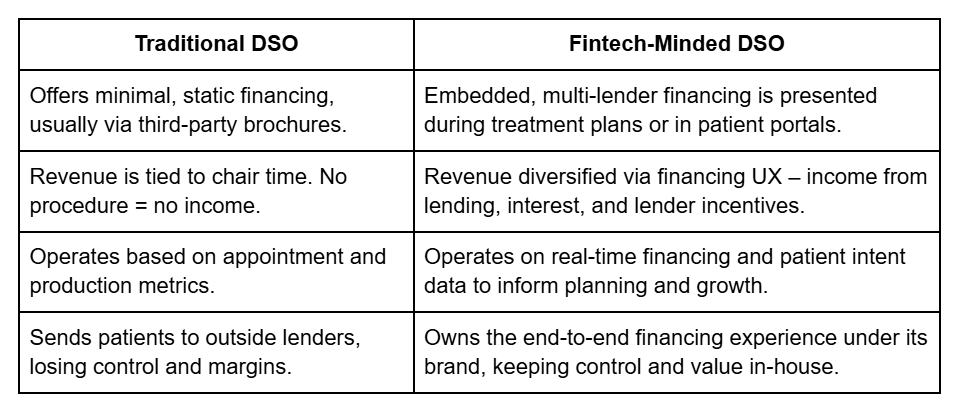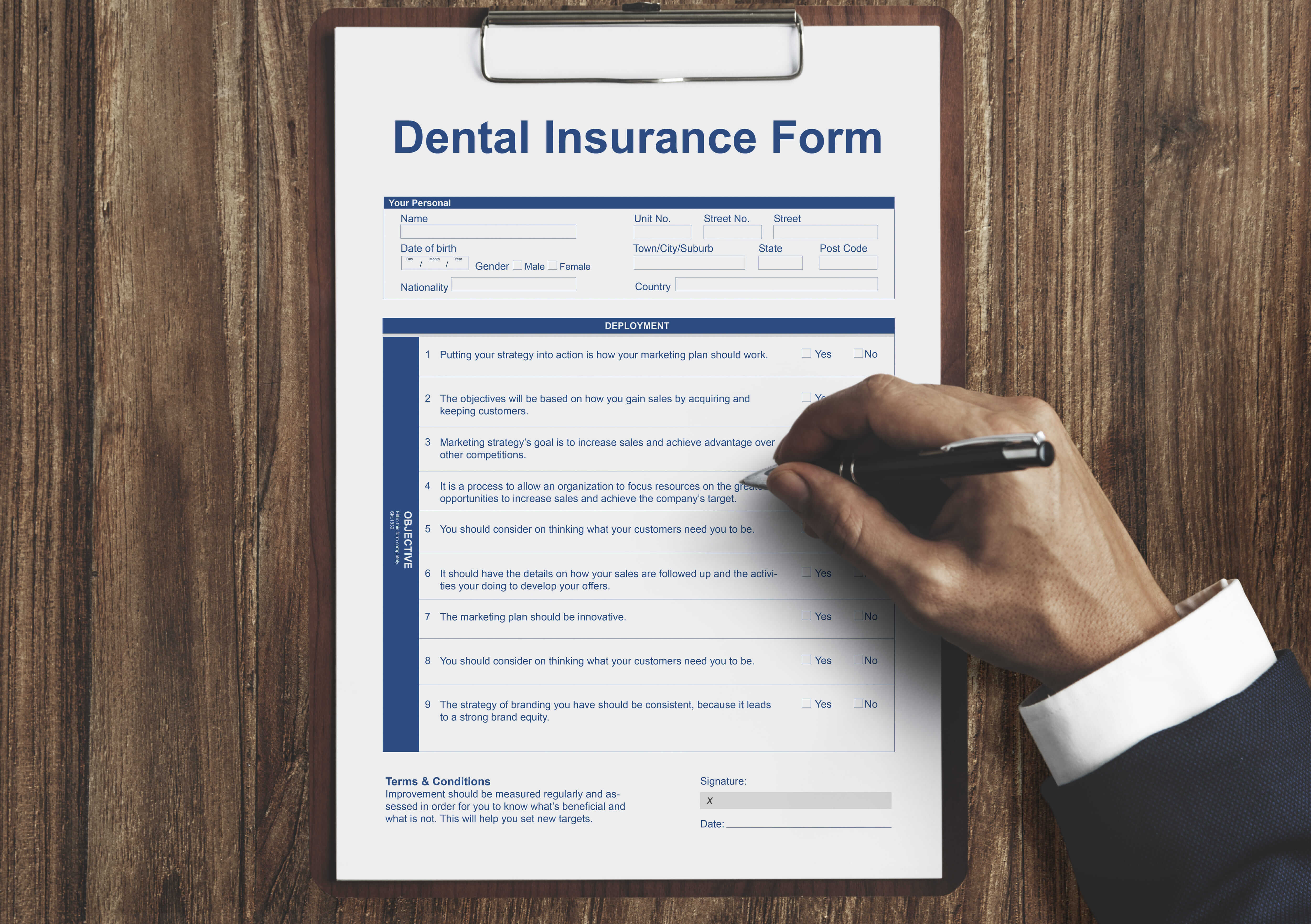Recession-Proofing Dental Revenue: Why the Smartest DSOs Are Acting Like Fintechs

A new class of DSOs isn’t just accepting payments; they’re financing like Klarna, analyzing like Stripe, and growing like fintechs. Here's why your DSO should too.
Introduction
The latest data from the American Dental Association’s Q2 2025 report paints a worrying picture for dental practices. Dentists' economic confidence has slumped, with a “noticeable decline” in optimism. At the same time, the cost of running a practice is surging – about a quarter of dentists said supply and equipment expenses jumped over 10% in just the first half of 2025. And yet, patient demand isn’t translating into booming revenue. Consumer dental spending has increased by only ~4% in the past year, remaining flat once inflation is factored in. High inflation, flat growth, and low confidence are a storm for shrinking margins.
But what if the problem isn’t just economic conditions? What if the real issue is how DSOs think about revenue? The central thesis of this article: The DSO of the future doesn’t just deliver care – it delivers capital. In an uncertain economy, the smartest DSOs act more like fintechs. Those that do will recession-proof their revenue. Those who don’t risk stagnation.
The Hidden Fragility in DSO Revenue Models
On the surface, many dental practices appear to be thriving, and schedules are nearly full. The ADA reports schedules at 86% capacity. But even full chairs mask shrinking margins. Costs like PPE, lab fees, and wages have soared, yet 85%+ of dentists say insurance reimbursements have stayed flat or declined. Raising fees or improving efficiency can’t keep up with inflation. The result? Full schedules with underwhelming profits.
Meanwhile, a quieter issue erodes revenue: patients deferring high-value treatment because they can’t afford it upfront. A recent survey found 92% of Americans would consider delaying dental care due to cost, and 83% said they might delay emergency care if the bill is too high. That’s not a lack of trust, it’s a lack of funds.
More than half of new dental patients never return after their first visit (59% of Dental Patients Ghost After Visit #1 - read the full blog here). Nearly 6 in 10 ghosts often because of cost confusion or sticker shock. These patients leave with unaccepted treatment plans not due to lack of need, but because they’re “unfunded.” That’s millions in potential revenue walking out the door.
Being busy ≠ being profitable. Without health care patient financing solutions in place, DSOs leave millions in revenue on the table. A full schedule doesn’t guarantee a full bank account, especially when patients can’t say “yes” to big-ticket care.
How Fintech Changed Expectations and What DSOs Can Learn
Why are even willing patients walking away from treatment? Fintech has dramatically reshaped how consumers expect to pay for goods and services, including healthcare.
In the past few years, fintech innovation has trained consumers to expect:
- Instant credit approvals
- Buy Now, Pay Later (BNPL) options
- Seamless, embedded financing at the point of sale
Today, this experience is everywhere, from buying an iPhone at Apple to splitting groceries on Amazon.
Consumer adoption tells the story:
- As of 2023, 14% of U.S. adults had used BNPL, up from 10% in 2021
- 72% of Americans say they plan to use it in the next year
- The global BNPL market topped $378 billion in 2023 and continues growing at ~40% annually
Payment flexibility is no longer a perk; it’s an expectation. And younger generations, in particular, are driving this shift.
Healthcare Hasn’t Kept Up
Most dental payment experiences remain clunky and outdated. Patients are often:
- Handed an estimate with no financing attached
- Expected to pay large sums upfront or apply for high-interest credit cards
- Referred to third-party sites that break the trust and flow of care
This disconnect frustrates patients and contributes to treatment abandonment, especially when there are limited patient health care financing options directly integrated into the experience.
DSOs Are Uniquely Positioned to Close the Gap
Unlike fintech startups that spend years building infrastructure, DSOs already have the key ingredients:
- Data: Insight into patient needs and treatment plans
- Trust: A clinical relationship with the patient
- Distribution: A broad base of locations and recurring patient touchpoints
DSOs already have what fintechs are chasing; they just need the rails.
What Today’s Patients Want - Before They Even Book
According to a CareCredit study:
- 67% of patients research financing options before looking up procedures
- Just 58% research the clinical treatment details first
- Nearly 50% say they’re very likely to apply for financing if treatment exceeds $1,000
These aren’t post-treatment considerations, they’re top-of-funnel expectations. Patients now assume that health care financing for patients will be part of the experience.
Why DSOs Should Offer Patient Financing Plans
To keep up with patient expectations, DSOs must:
- Integrate financing into the treatment plan conversation, not bolt it on after the fact
- Make credit options fast, simple, and embedded in the patient portal or checkout process
- Avoid sending patients to external websites, which can feel risky or confusing
- Treat financing as a service — one that builds loyalty and closes more care
Offering patient financing plans isn’t just about getting paid. It tells patients: “We understand your reality and we’re here to help.”
What a Fintech-Minded DSO Looks Like

The fintech-minded DSO doesn’t treat financing as an afterthought; it’s strategic. You’re not just pulling teeth; you’re pushing capital. You’re enabling the flow of money to make care possible and profitable.
The model mirrors car dealerships. They once sold cars, and banks financed them. Now, many have in-house financing arms. Why? Because owning financing drives sales, approvals, and profit. DSOs are at the same inflection point.
The DSO of the future operates like a fintech platform with dental offices.
How FinMkt Powers the Transformation
DSOs don’t need to build fintech from scratch. FinMkt provides the “rails” for embedded financing. It’s a turnkey platform purpose-built for enterprises like DSOs.
Key FinMkt Capabilities:
- Multi-lender waterfall financing: A single application scans a network of lenders to find the best terms, dramatically increasing approvals and reducing rejections.
- Embedded UX: Financing lives inside your own systems, offered during checkout or via branded patient portals. No third-party redirects or brochures.
- Trust + Control: DSOs retain control of branding and process. Patients see financing as part of care, not a separate, confusing step.
- Data transparency: FinMkt provides metrics on approvals, loan sizes, usage, and revenue impact, helping you optimize your financing strategy.
- Support for captive lending: If you want to become the lender, FinMkt powers that too, offering underwriting and servicing infrastructure.
FinMkt equips DSOs to act like fintechs, without building tech in-house.
Strategic Upside Beyond Patient Payments
Financing platforms like FinMkt empower DSOs to unlock strategic growth by enabling health care financing for patients through embedded, multi-lender solutions.
1. New Revenue Streams
By facilitating loans, DSOs can earn interest, lender rebates, or retain margins otherwise lost to merchant fees. With captive lending or co-lending, you’re no longer giving away financing revenue; you’re monetizing it.
2. Better Capacity Planning
Financing data reveals real demand. If 100 patients are approved but only 60 scheduled, you know 40 are ready if you expand. This helps guide investments in OR time, providers, or locations with confidence.
3. Improved Patient Lifetime Value
When patients have flexible payment options, they say “yes” to comprehensive treatment and elective care more often. This leads to healthier patients, faster treatment completion, and higher lifetime revenue.
4. Predictable Cash Flow
Third-party or in-house financing often pays practices quickly, sometimes within days. That improves cash flow consistency and reduces dependence on patient pay plans or insurance delays.
Conclusion: From Practice to Platform
DSOs have survived recessions and shifts before. Those who adapt thrive. Today’s adaptation is about upgrading the infrastructure that supports revenue.
By embedding fintech and offering financing natively, DSOs can transform from traditional care providers into platforms for oral health and financial access.
The most resilient DSOs in 2025 and beyond won’t just do dentistry. They’ll be care-finance platforms powered by partners like FinMkt.
Every patient who walks through your doors should get:
- Trusted care
- And a personalized path to afford it.
That’s how DSOs grow in tough times, not by marketing harder, but by making it easy for patients to say “yes.”
If you’re ready to future-proof your dental revenue, Book a FinMkt Strategy Session. Learn how embedded financing would work inside your DSO with a brief audit.
The best investment in an uncertain economy is in infrastructure that helps patients move forward with care. Deliver care. Deliver capital. That’s the model of tomorrow’s DSO available to you today.

















